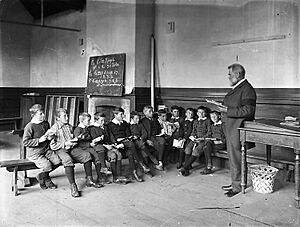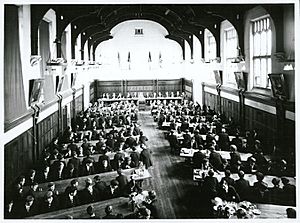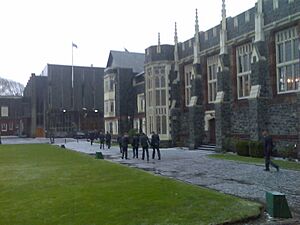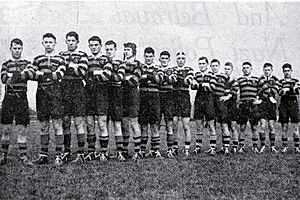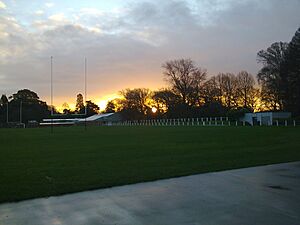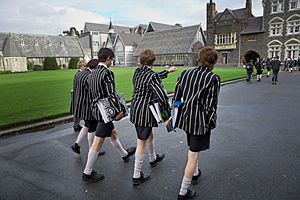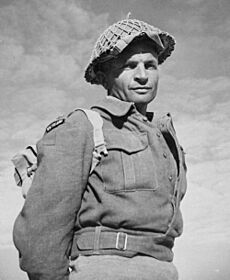Christ's College, Christchurch facts for kids
Quick facts for kids Christ's College Canterbury |
|
|---|---|
| Address | |
| Coordinates | 43°31′47″S 172°37′33″E / 43.52972°S 172.62583°E |
| Information | |
| Type | Independent, Single-sex, Secondary (Years 9–13), Day & Boarding |
| Motto | Latin: Bene tradita, bene servanda (Good traditions, Well maintained) |
| Religious affiliation(s) | Anglicanism |
| Established | 1850 |
| Ministry of Education Institution no. | 330 |
| Chairman | Hugh Lindo |
| Principal | Joe Eccleton |
| Chaplain | Rev'd Cameron Pickering |
| School roll | 734 (February 2024) |
| Alumni | Christ's College Old Boys |
Christ's College, Canterbury, is a private school for boys in Christchurch, New Zealand. It is an Anglican school, meaning it has ties to the Church of England. Boys can attend as day students or live at the school as boarders.
The school was started in 1850 by Reverend Henry Jacobs in Lyttelton. It was created to educate the children of early settlers. This makes Christ's College the oldest private school in New Zealand. Today, about 698 students from Year 9 to Year 13 attend the college.
Christ's College is a member of two important international groups. It is part of The Headmasters' and Headmistresses' Conference (HMC). This group includes leaders from top independent schools in the UK, Ireland, and other Commonwealth countries. Christ's College is one of only three New Zealand schools in HMC. It is also a member of Round Square. This is a global network of 230 schools in 50 countries. Round Square schools focus on developing students through challenges and service.
Contents
School History
Christ's College was founded in 1850. It was designed to be like famous English private schools, such as Eton College. The school was likely named Christ's College by James FitzGerald. He was Canterbury's first leader and had attended Christ's College, Cambridge.
When it first opened, the school operated from two rooms in Lyttelton. The main focus was on a classical education. This included subjects like Greek, Latin, and Mathematics. Students also learned Modern languages, English, History, and Geography. They were also expected to do science experiments, draw, and sing.
In 1852, the school moved to the St Michael's parsonage in Oxford Terrace. It had 16 students at this time. The first headmaster, Henry Jacobs, made sure both day students and boarders could attend.
Christ's College moved to its current location in 1856. There were 35 students and three teachers. This new site was next to the Government Domain, now Hagley Park. This gave the school space to grow. Over time, more buildings were added. The first buildings were made of wood. They provided homes for staff and more boarders.
By 1863, the first stone building, Big School, was built. It is now the school's library and is the oldest educational building still used in New Zealand. The Chapel was built in 1867. The school grew around a central area called the 'quad'. Students are not allowed to walk on the quad out of respect.
In its early days, the college taught boys as young as six. Students had different levels of education. This meant a wide age range in many classes. All students were taught together until more classrooms were built.
The school's motto is Bene Tradita, Bene Servanda. This Latin phrase means "good traditions, well maintained."
School Campus
The original plan for central Christchurch in 1850 suggested Christ's College and ChristChurch Cathedral be built next to each other. This was planned for Cathedral Square. However, the land set aside for the college was too small. In 1853, a new site was chosen next to the Government Domain. This is where the school is located today. The college received a much larger piece of land, about 10 acres.
The Christ's College campus has many buildings from the 1800s and early 1900s. There are also newer buildings, like the Old Boys Theatre. Most buildings are in a neogothic style. This style was popular for important buildings in Christchurch. 'Big School', built in 1863, was the first classroom on the Christchurch site. It is one of New Zealand's oldest surviving school buildings.
College House
College House was started as part of Christ's College in 1850. It helped establish Canterbury University in the early 1870s. The part of Christ's College that taught university students became known as College House. In 1957, College House became a separate, independent residential college for the university.
School Fees
As a private school, Christ's College charges fees. For the 2025 school year, tuition fees for New Zealand students are $34,190 per year. If a student lives at the school, boarding fees are an extra $22,250 per year.
As of August 2025, Christ's College has 698 students. About 10% of these students identify as Māori.
College Life
Chapel Services
The chapel is a very important part of school life. Religious education is required until Year 11. Every Wednesday, the whole school practices singing hymns and prayers. Boys must also attend chapel on Monday and Friday mornings. They usually attend on alternate Sundays too. The school chapel service is a priority. Parents and family are welcome to attend Sunday services.
Music is also a big part of school life. The Christ's College Chapel Choir has about eighty boys. The choir sings at chapel services and other events. They also take part in singing competitions. In 2007, they won second place at an international festival in Vienna.
What Students Learn
The school offers students NCEA Levels 2 and 3. These are national qualifications in New Zealand. They also offer scholarship examinations. From 2022, the school stopped offering NCEA Level 1. Instead, they have their own 'College Diploma'. This is a two-year course for Year 10 and 11 students.
Many subjects are offered at the school. These include English, Mathematics, French, drama, and sciences. Mathematics is required up to Year 11. In Years 9, 10, and 11, students take a wide range of subjects. This helps them find what they enjoy before choosing subjects for NCEA Level 2 in Year 12.
Activities Outside of Class
Christ's College strongly encourages extra-curricular activities. Throughout the year, students can join many groups. These include speech and drama, kapa haka (Māori performing arts), music, and debating. There are also Model United Nations and other activities.
Performing arts are a big part of college life. All boys are expected to take part in at least one activity. There is a Junior and Senior play each year. These are often done with Rangi Ruru Girls' School or St Margaret's College. There is also an annual House Singing competition. The REACTION House Play festival is where each house performs a play. Students are encouraged to try new activities, especially in these inter-house competitions.
Sports at College
Sport is required for all boys. There is a wide choice of sports. Boys choose a summer and a winter sport each year. Besides school sports, there are ongoing inter-house sports competitions. All students are expected to play or support their house. Extra sports activities are also available. For example, the school ski club goes to ski fields on weekends in winter.
The school has many sports facilities. These include the Upper playing field, an all-weather facility, and an indoor swimming pool. There is also a gymnasium and a weights room. Off-site facilities include the Christ's College cricket ground. This ground is in South Hagley Park. Kerr's Reach on the Avon River is home to the Christ's College rowing club.
It is believed that a form of rugby was played at the school as early as 1853. Each year, the rugby team plays in a tournament called the "Quadrangular." This tournament is against Wanganui Collegiate School, Wellington College, and Nelson College. Christ's College also has a strong rivalry with Christchurch Boys' High School. An annual rugby match between the two schools is very competitive.
House System
Christ's College has ten Houses for its 700 students. This is a tradition from English private schools. There are three boarding houses where students live. The other seven houses are for day students. Each house has a housemaster who looks after the boys.
In the early days, houses were for boarders. Their names changed as teachers came and went. The name Jacobs has stayed, while others are now School, Richards, and Flower's. The first two day-boy houses were started in 1909. They were called 'North Town' and 'South Town'. Students were placed based on whether their homes were north or south of Gloucester Street. In 1924, these houses were named Harper and Julius. Condell's, Corfe, Rolleston, and Somes were added later.
Students in each house are encouraged to build house spirit. They compete in sports and cultural events. Cricket and football games started early on. Music and drama competitions have also been added.
Day Houses
- Condell's
- Corfe
- Harper
- Julius
- Rolleston
- Somes
- Jacobs (became a day house at the end of 2016)
Day houses give students a place to study and relax. They have a common room, showers, and changing rooms. There are also areas to store books and sports gear. Boys meet here each morning for House Assembly. They get notices and reminders from their Housemaster.
Boarding Houses
- Flower's
- Richards
- School
Boarding houses offer more support and facilities. An assistant housemaster, a matron, and two live-in tutors help the Housemaster. Most school facilities are open to boarders after school hours. These include the library, computer room, gym, and music rooms. Evening activities include time for homework and also fun activities.
The Christ's College Boarding Programme keeps boarders busy on weekends. They have age-appropriate activities. These give boarders opportunities that day students might not have.
School Uniform
The black and white striped blazers and ties worn by Christ's College boys are well-known. There are two types of uniform: Sports Uniform and Dress Uniform. Students call the Dress Uniform "stripes" or "suits." During winter, Dress Uniform is worn on Mondays and Fridays. Sports Uniform is worn on Tuesday, Wednesday, and Thursday. Dress Uniform is needed for chapel services and other formal events.
A high standard of dress is always expected. Boys are disciplined for wearing the uniform incorrectly. They must always wear their blazers when in town, even with the summer uniform.
Each house has a different uniform for inter-house sports events. This includes a rugby jersey or singlet in the house colour. Black or white shorts are worn depending on the house. Each sport also has its own uniform for games. A black tracksuit with the College crest is needed for travel to and from games.
School Leadership
The Christ's College governing body includes a chairman, a Warden, and Fellows. The Bishop of Christchurch is automatically the Warden.
Current Leaders
- Warden: Bishop of Canterbury, Peter Carrell
- Executive Principal: Joe Eccleton
Notable Alumni
Former students of Christ's College are called Old Boys. They can join the Christ's College Old Boys' Association (CCOBA). Here are some notable Old Boys:
Academia (Education and Research)
- John McMillan (1951–2007), a professor at Stanford University.
- Murray C. Wells (born 1936), a retired professor at the University of Sydney.
- Robin Williams (1919–2013), a mathematician and university leader.
Business Leaders
- John Anderson (1945–2018), a former chief executive of ANZ National Bank.
- Bill Hamilton (1899–1978), who invented the jet boat.
- Miles Warren (1929–2022), a famous architect.
Entertainment, Media, and Arts
- Denis Glover (1912–1980), a poet.
- Mark Hadlow (born 1957), an actor.
- Leigh Hart (born 1970), a comedian and actor.
- Sam Neill (born 1947), a well-known actor.
- William Pember Reeves (1857–1932), an author and historian.
- Teddy Tahu Rhodes (born 1966), a singer.
Military Heroes
- Colin Falkland Gray, New Zealand’s top RAF flying ace in World War 2.
- Edgar Kain (1918–1940), the first RAF flying ace in World War 2.
- Charles Upham (1908–1994), a war hero who won the Victoria Cross twice.
Public Service (Government and Community)
- Michael Cullen (1945–2021), a former Deputy Prime Minister and Minister for Finance.
- Michael Fowler (born 1929), an architect and former Mayor of Wellington.
- Sam Johnson (born 1989), who organized the Student Volunteer Army.
- Derek Quigley (born 1932), a former Member of Parliament.
- Andrew Tipping (born 1942), a former Justice of the Supreme Court of New Zealand.
Religion
- Charles Drennan (born 1960), a former Roman Catholic Bishop.
- Peter Carrell (born 1959), the current Anglican Bishop of Christchurch.
Science and Medicine
- Edward Sayers (1902–1985), a doctor and medical school dean.
- John Yaldwyn (1929–2005), a scientist and former Director of Te Papa (New Zealand's national museum).
Sports Stars
- Robbie Deans (born 1959), a former All Black rugby player and coach.
- Peter Fulton (born 1979), a New Zealand cricketer.
- Jock Hobbs (1960–2012), a former All Black and chairman of NZ Rugby.
- James Lassche (born 1989), an Olympic rower.
- Tom Lowry (1898–1976), New Zealand's first Test cricket captain.
- Joe Moody (born 1988), a current All Black rugby player.
- Damian McKenzie (born 1995), a current All Black rugby player.
- John Wright (born 1954), a former New Zealand cricket captain and coach.
See also
- Lists of schools in New Zealand
- List of boarding schools


